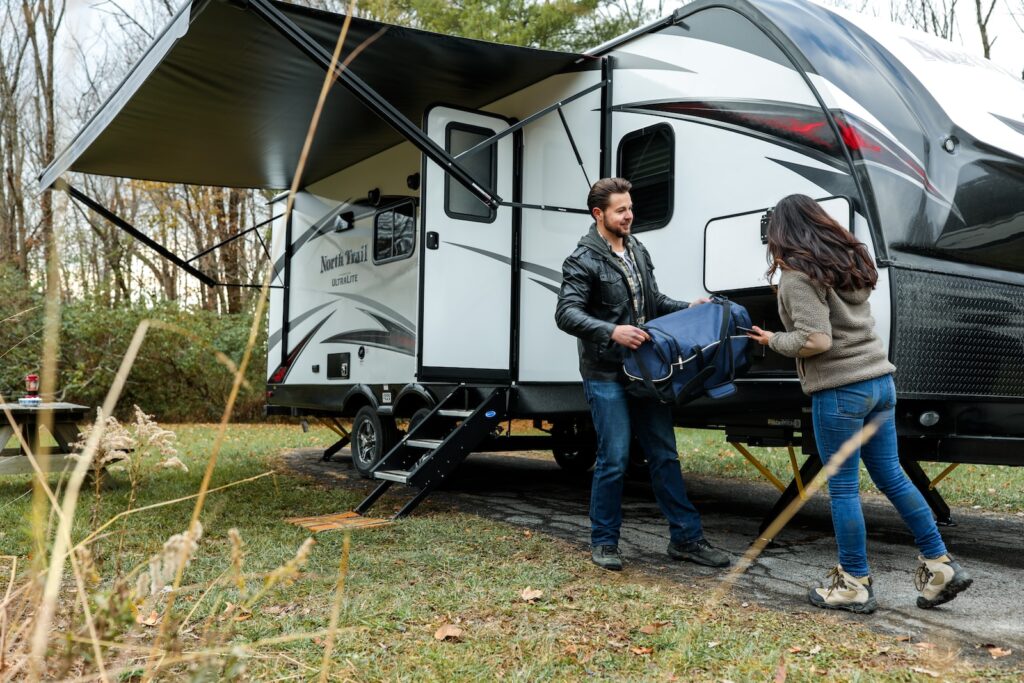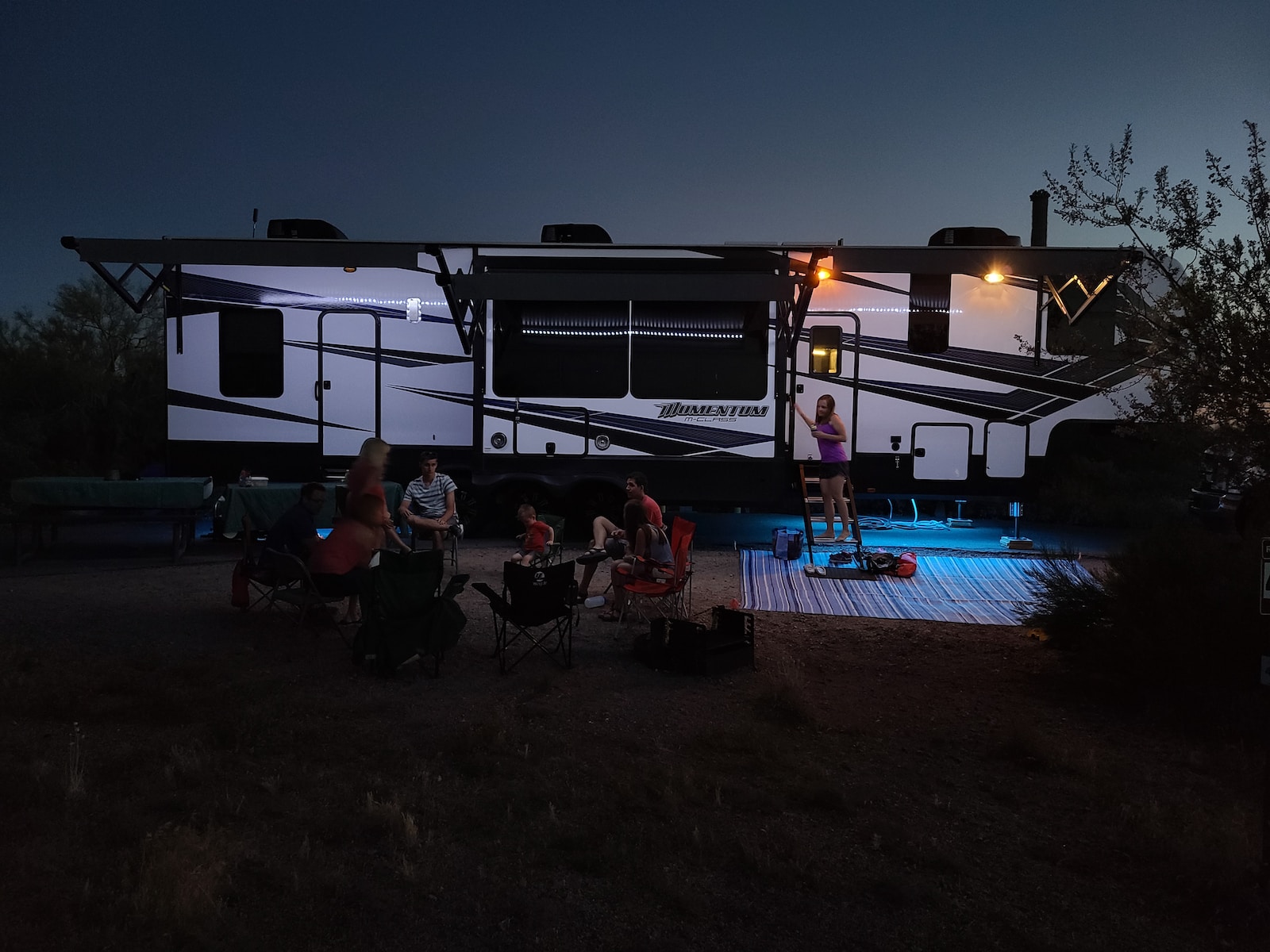Are you a proud owner of an RV? If so, you’re probably familiar with the importance of having a reliable battery to power your adventures on the road. But with so many different types of batteries available for RVs, how do you know which one is the best fit for your specific needs? In this article, we will explore the various RV battery types and help you determine the one that suits you best. Whether you’re a weekend warrior or a full-time RVer, finding the right battery can make all the difference in your camping experience. So, let’s dive in and discover which RV battery type is the perfect match for you.
Lead-Acid Batteries
Lead-Acid Batteries are one of the most common types of batteries used in RVs. There are two main categories of lead-acid batteries: flooded lead-acid batteries and deep cycle lead-acid batteries.
Flooded Lead-Acid Batteries
Flooded lead-acid batteries, also known as wet-cell batteries, are the traditional and most economical option for RV owners. These batteries have removable caps on top, allowing for easy access to check and refill the distilled water levels inside. The plates inside the battery are immersed in an electrolyte solution, which allows for the flow of electric current.
One of the advantages of flooded lead-acid batteries is their ability to handle high current demands, making them suitable for starting the RV engine. However, they require regular maintenance in the form of checking and maintaining the water levels, which can be a bit tedious for some RV owners.
Deep Cycle Lead-Acid Batteries
Deep cycle lead-acid batteries, on the other hand, are specifically designed for long-lasting, deep discharges. These batteries are ideal for powering the various appliances and electronics in an RV, such as lights, refrigerator, and entertainment systems.
Deep cycle batteries have thicker plates compared to flooded lead-acid batteries, allowing them to withstand frequent deep cycling. This means they can be discharged to a larger extent without being significantly affected in terms of performance and longevity.
While deep cycle lead-acid batteries also require regular maintenance, they typically have higher reserve capacity and longer lifespan compared to flooded lead-acid batteries.
Absorbent Glass Mat (AGM) Batteries
Absorbent Glass Mat (AGM) batteries have gained popularity among RV owners due to their maintenance-free nature and durability. AGM batteries use a fiberglass mat between the plates to hold the electrolyte, instead of being submerged in a liquid electrolyte solution like flooded lead-acid batteries.
AGM batteries offer several advantages, including greater vibration resistance, faster recharging times, and a longer lifespan compared to flooded lead-acid batteries. They are also less prone to sulfation, which occurs when the battery is not fully charged and can negatively affect its performance.
These batteries are sealed and do not require regular water maintenance like flooded lead-acid batteries, making them a hassle-free option for RV owners. However, they are generally more expensive than flooded lead-acid batteries.
Gel Batteries
Gel batteries, also known as gel cell batteries, are another type of sealed lead-acid battery commonly used in RVs. These batteries utilize a gel-like electrolyte, which immobilizes the sulfuric acid and prevents leakage.
Gel batteries offer excellent deep cycle capabilities and are highly resistant to shock and vibration. They have a slower self-discharge rate compared to flooded lead-acid batteries, making them suitable for long periods of inactivity.
These batteries are also maintenance-free and have a longer lifespan compared to flooded lead-acid batteries. However, they are typically more expensive and have a lower tolerance for high heat conditions.
Lithium-Ion Batteries
Lithium-Ion Batteries have gained popularity in recent years due to their numerous advantages over lead-acid batteries. These batteries are lightweight and have a significantly higher energy density, allowing them to store more energy in a smaller and lighter package.
Advantages of Lithium-Ion Batteries
One of the most significant advantages of lithium-ion batteries is their higher usable capacity. Unlike lead-acid batteries, lithium-ion batteries can be discharged to a much larger extent without affecting their performance and lifespan. This means that RV owners can utilize more of the battery’s capacity, providing extended power for their appliances and electronics.
Additionally, lithium-ion batteries have a much longer lifespan compared to lead-acid batteries. They can last up to ten years or more, depending on usage and maintenance, whereas lead-acid batteries typically last around three to five years. This longer lifespan ultimately leads to cost savings in the long run, despite the higher initial cost of lithium-ion batteries.
Another advantage of lithium-ion batteries is their faster charging capabilities. These batteries can be recharged at a much quicker rate compared to lead-acid batteries, allowing RV owners to get back on the road sooner. They also have a lower self-discharge rate, meaning they can hold their charge for longer periods of inactivity.
Disadvantages of Lithium-Ion Batteries
Despite their advantages, lithium-ion batteries do have a few drawbacks. One of the main disadvantages is their higher upfront cost. Lithium-ion batteries are more expensive compared to lead-acid batteries, making them less accessible to some RV owners.
Furthermore, lithium-ion batteries require a specialized battery management system (BMS) to prevent overcharging, over-discharging, and overheating. This adds to the overall cost and complexity of the battery system.
Another consideration with lithium-ion batteries is their safety. While modern lithium-ion batteries are generally safe, improper handling, charging, or discharging can lead to thermal runaway and the release of harmful gases. Proper care and precautions must be taken when using and maintaining lithium-ion batteries.
Size and Capacity Considerations
When choosing an RV battery, it is crucial to consider its size and capacity to meet your power requirements. Two common metrics used to determine the capacity of a battery are amp-hours (Ah) and reserve capacity (RC).
Amp-hours (Ah) and Reserve Capacity (RC)
Amp-hours (Ah) is a measure of the battery’s capacity to deliver a certain amount of current over a period of time. In simple terms, it represents how long a battery can provide a specific amount of current before needing to be recharged. The higher the amp-hour rating, the longer the battery can power your RV’s appliances and electronics.
Reserve capacity (RC) is another measure of a battery’s capacity, specifically its ability to deliver a consistent amount of power over an extended period. It represents the number of minutes a battery can consistently deliver a specific current before reaching a certain voltage level.
When choosing an RV battery, it is essential to consider both the amp-hour rating and reserve capacity to ensure that the battery can meet your power requirements for an extended period of time.
Physical Size and Weight
In addition to capacity, the physical size and weight of the battery are also important factors to consider. RVs have limited storage space, so it is crucial to choose a battery that can fit within the designated compartment.
Lead-acid batteries, particularly flooded batteries, are generally larger and heavier compared to lithium-ion batteries. Lithium-ion batteries, on the other hand, are compact and lightweight, making them a popular choice for RV owners looking to maximize their storage space and reduce overall weight.
Before purchasing an RV battery, it is recommended to check the physical dimensions and weight specifications to ensure compatibility and ease of installation.
Maintenance Requirements
Different types of RV batteries have varying maintenance requirements, and understanding these requirements is crucial for proper battery care and longevity.
Watering Requirements for Lead-Acid Batteries
Flooded lead-acid batteries require regular maintenance of checking and maintaining the water levels in the battery cells. The electrolyte inside these batteries evaporates over time, and distilled water needs to be replenished to maintain proper electrolyte levels.
It is important to check the water levels periodically, especially in hot climates or during heavy usage, to prevent the plates from being exposed to air. Adding distilled water when necessary will ensure that the batteries stay properly hydrated and perform optimally.
Self-Discharge Rates
Another maintenance consideration is the self-discharge rate of the battery. Self-discharge refers to the gradual loss of charge over time when the battery is not in use.
Lead-acid batteries, especially flooded batteries, have a higher self-discharge rate compared to lithium-ion batteries. This means that they lose their charge more quickly when not in use, requiring regular recharging to prevent complete discharge.
Lithium-ion batteries, on the other hand, have a lower self-discharge rate, allowing them to hold their charge for longer periods of inactivity. This is particularly useful for RV owners who may store their vehicles for extended periods between trips.

Charging Methods
Keeping your RV battery charged is essential to ensure a continuous power supply while on the road. There are different charging methods available, depending on your power source and preferences.
Converter Chargers
Converter chargers are commonly used in RVs to convert the alternating current (AC) from a campground power source or generator into direct current (DC) to charge the battery and power the RV’s electrical system.
These chargers typically have built-in charging algorithms that adjust the charging voltage and current based on the battery’s requirements. This helps ensure proper charging and prevents overcharging, which can lead to battery damage.
Inverter Chargers
Inverter chargers, as the name suggests, have both inverter and charging capabilities. Apart from converting DC power from the battery into AC power for running appliances, they also have a built-in charging system.
Inverter chargers can charge the battery from an AC power source, such as a campground hookup or a generator, while simultaneously providing power to the RV’s electrical system. This allows for efficient charging and power supply, especially during times when both charging and usage are required.
Solar Chargers
Solar chargers are a popular alternative for RV owners who prefer renewable energy sources and want to be off the grid. These chargers utilize solar panels to convert sunlight into electricity, which is then used to charge the battery.
Solar chargers can be an excellent option for maintaining the battery’s charge while camping in remote locations or during extended stays without access to a power hookup or generator. They are environmentally friendly and can provide a reliable source of power as long as there is sufficient sunlight.
When choosing a charging method for your RV battery, it is essential to consider your power needs, camping habits, and available resources to ensure a reliable and efficient charging solution.
Price and Lifespan
The price and lifespan of an RV battery are crucial factors to consider when making a purchase decision.
Initial Cost
Lead-acid batteries, particularly flooded batteries, generally have a lower initial cost compared to lithium-ion batteries. This makes them more accessible to RV owners on a budget or those looking for a cost-effective solution.
On the other hand, lithium-ion batteries have a higher upfront cost due to their advanced technology and superior performance. However, it is important to consider the long-term cost and lifespan of the battery to determine the overall value.
Lifespan and Long-Term Cost
Lead-acid batteries, including flooded, deep cycle, AGM, and gel batteries, typically have a lifespan ranging from three to five years. Regular maintenance, proper charging, and usage practices can help maximize the lifespan of these batteries.
Lithium-ion batteries, on the other hand, have a significantly longer lifespan, lasting up to ten years or more with proper care. While they have a higher upfront cost, their longevity can result in cost savings in the long run, as they may not need to be replaced as frequently as lead-acid batteries.
When considering the price and lifespan of an RV battery, it is important to weigh the initial investment against the long-term cost and benefits to make an informed decision.

Power Requirements
Determining your power needs is crucial for selecting the right RV battery that can effectively power your appliances and electronics.
Determining Your Power Needs
Start by making a list of all the appliances and electronics you intend to run with the battery. Consider their power requirements in terms of watts or amps. This information is usually mentioned on the appliance or in the user manual.
Add up the power requirements of all the devices to determine the total power consumption. This will give you an idea of the capacity required from the RV battery.
It is advisable to add a buffer to the calculated power consumption to account for any unforeseen power requirements or future additions to your RV’s electrical system.
Powering Appliances and Electronics
Different appliances and electronics have varying power requirements, and it is important to ensure that the chosen RV battery can meet these requirements.
For example, larger appliances like refrigerators and air conditioners usually require more power, especially during startup. Deep cycle lead-acid batteries or lithium-ion batteries are more suitable for running these power-hungry devices effectively.
Smaller devices like lights, fans, and electronics can be powered by a wider range of battery options, including flooded lead-acid batteries, AGM batteries, gel batteries, or lithium-ion batteries.
Understanding your power needs and matching them with the appropriate battery type will help ensure a reliable and efficient power supply for your RV.
Environment and Safety
Considering the environmental impact and safety aspects of RV batteries is essential for responsible usage and proper disposal.
Environmental Impact
Lead-acid batteries, especially flooded batteries, contain lead and sulfuric acid, which can be harmful to the environment if not handled and disposed of properly. It is crucial to follow local regulations and guidelines for battery disposal to minimize environmental pollution.
Lithium-ion batteries, while generally more environmentally friendly compared to lead-acid batteries, still require proper disposal. They contain toxic materials like lithium and cobalt, which can pose risks if not handled responsibly.
RV owners should educate themselves about battery recycling programs in their area and take the necessary steps to ensure the safe and environmentally conscious disposal of their used batteries.
Safety Considerations
Safety should always be a top priority when dealing with RV batteries. Regardless of the battery type, it is important to follow manufacturer guidelines and recommended practices for safe usage and maintenance.
Lead-acid batteries can release flammable hydrogen gas during charging, which is why they should be installed and used in a well-ventilated area. These batteries should also be protected from extreme temperatures, as excessive heat or cold can affect their performance and lifespan.
Lithium-ion batteries, while generally safe when handled correctly, can pose risks if mishandled or abused. It is important to avoid overcharging or deep discharging these batteries, as well as exposing them to high temperatures, which can lead to thermal runaway or fire hazards.
Proper education, adherence to safety guidelines, and regular inspection of the battery system can help minimize safety risks and ensure a safe RV experience.
Compatibility with RV Systems
When choosing an RV battery, it is important to consider its compatibility with your RV’s electrical system and requirements.
Voltage Requirements
RVs typically have a 12-volt electrical system, which means that the battery needs to provide 12 volts of direct current (DC) to power the various appliances and electronics.
Most lead-acid batteries, including flooded lead-acid batteries, AGM batteries, and gel batteries, are designed to provide 12 volts of DC power, making them compatible with RV systems.
Lithium-ion batteries, however, have a higher voltage output compared to lead-acid batteries. RV owners considering lithium-ion batteries should ensure that their electrical system and devices can handle the higher voltage.
Compatibility with Inverter Systems
Some RVs have an inverter system installed, which allows for the conversion of DC power from the battery into AC power to run appliances. It is important to ensure that the chosen RV battery is compatible with the inverter system and can provide the necessary power for AC appliances.
Lead-acid batteries, including deep cycle batteries, AGM batteries, and gel batteries, are compatible with most inverter systems and can effectively power AC appliances.
Lithium-ion batteries, with their higher energy density and superior power output, can provide reliable power for both DC and AC appliances, making them a versatile option for RV owners with inverter systems.
Understanding the voltage requirements and compatibility with your RV’s electrical system is crucial for choosing an RV battery that can seamlessly integrate with your setup and provide the power you need.
Summary and Conclusion
Choosing the right RV battery is a crucial decision that can impact the performance, longevity, and overall enjoyment of your RV adventures. Lead-acid batteries, including flooded lead-acid batteries, deep cycle lead-acid batteries, AGM batteries, and gel batteries, have been the longtime standard for RVs, offering a range of options to meet different power needs and budgets.
However, with advancements in technology and the increasing demand for more power and longer lifespan, lithium-ion batteries have emerged as a popular alternative. Lithium-ion batteries offer numerous advantages, including higher usable capacity, longer lifespan, faster charging capabilities, and a lighter weight.
When selecting an RV battery, it is important to consider factors such as capacity, size, maintenance requirements, charging methods, price, lifespan, power requirements, environmental impact, safety, and compatibility with your RV’s systems. Understanding these factors will help you make an informed decision and choose the battery that best meets your specific needs.
Regardless of the battery type, proper maintenance and responsible usage are essential for optimizing the battery’s performance and lifespan. Regular inspection, charging, and adherence to safety guidelines will ensure a reliable and efficient power supply for your RV, allowing you to enjoy your adventures on the road with peace of mind.
Affiliate Disclosure: Some of the links on our website are affiliate links, meaning we may earn a small commission if you make a purchase through these links. This helps support our website and keeps our content free for our readers.




